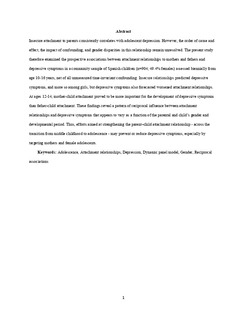| dc.contributor.author | Cortes-Garcia, Laura | |
| dc.contributor.author | Wichstrøm, Lars | |
| dc.contributor.author | Viddal, Kristine Rensvik | |
| dc.contributor.author | Senra, Carmen | |
| dc.date.accessioned | 2019-10-23T14:58:02Z | |
| dc.date.available | 2019-10-23T14:58:02Z | |
| dc.date.created | 2019-08-20T09:38:06Z | |
| dc.date.issued | 2019 | |
| dc.identifier.citation | Journal of Youth and Adolescence. 2019, . | nb_NO |
| dc.identifier.issn | 0047-2891 | |
| dc.identifier.uri | http://hdl.handle.net/11250/2624015 | |
| dc.description.abstract | Insecure attachment to parents consistently correlates with adolescent depression. However, the order of cause and effect, the impact of confounding, and gender disparities in this relationship remain unresolved. The present study therefore examined the prospective associations between attachment relationships to mothers and fathers and depressive symptoms in a community sample of Spanish children (n = 904; 49.4% females) assessed biennially from age 10–16 years, net of all unmeasured time-invariant confounding. Insecure relationships predicted depressive symptoms, and more so among girls, but depressive symptoms also forecasted worsened attachment relationships. At ages 12–14, mother–child attachment proved to be more important for the development of depressive symptoms than father–child attachment. These findings reveal a pattern of reciprocal influence between attachment relationships and depressive symptoms that appears to vary as a function of the parental and child’s gender and developmental period. Thus, efforts aimed at strengthening the parent–child attachment relationship—across the transition from middle childhood to adolescence—may prevent or reduce depressive symptoms, especially by targeting mothers and female adolescents. | nb_NO |
| dc.language.iso | eng | nb_NO |
| dc.publisher | Springer Verlag | nb_NO |
| dc.title | Prospective Bidirectional Associations between Attachment and Depressive Symptoms from Middle Childhood to Adolescence | nb_NO |
| dc.type | Journal article | nb_NO |
| dc.type | Peer reviewed | nb_NO |
| dc.description.version | acceptedVersion | nb_NO |
| dc.source.pagenumber | 15 | nb_NO |
| dc.source.journal | Journal of Youth and Adolescence | nb_NO |
| dc.identifier.doi | 10.1007/s10964-019-01081-4 | |
| dc.identifier.cristin | 1717272 | |
| dc.description.localcode | This is a post-peer-review, pre-copyedit version of an article published in [Journal of Youth and Adolescence] Locked until 15.7.2020 due to copyright restrictions. The final authenticated version is available online at: https://doi.org/10.1007/s10964-019-01081-4 | nb_NO |
| cristin.unitcode | 194,67,40,0 | |
| cristin.unitname | Institutt for psykologi | |
| cristin.ispublished | true | |
| cristin.fulltext | preprint | |
| cristin.qualitycode | 1 | |
